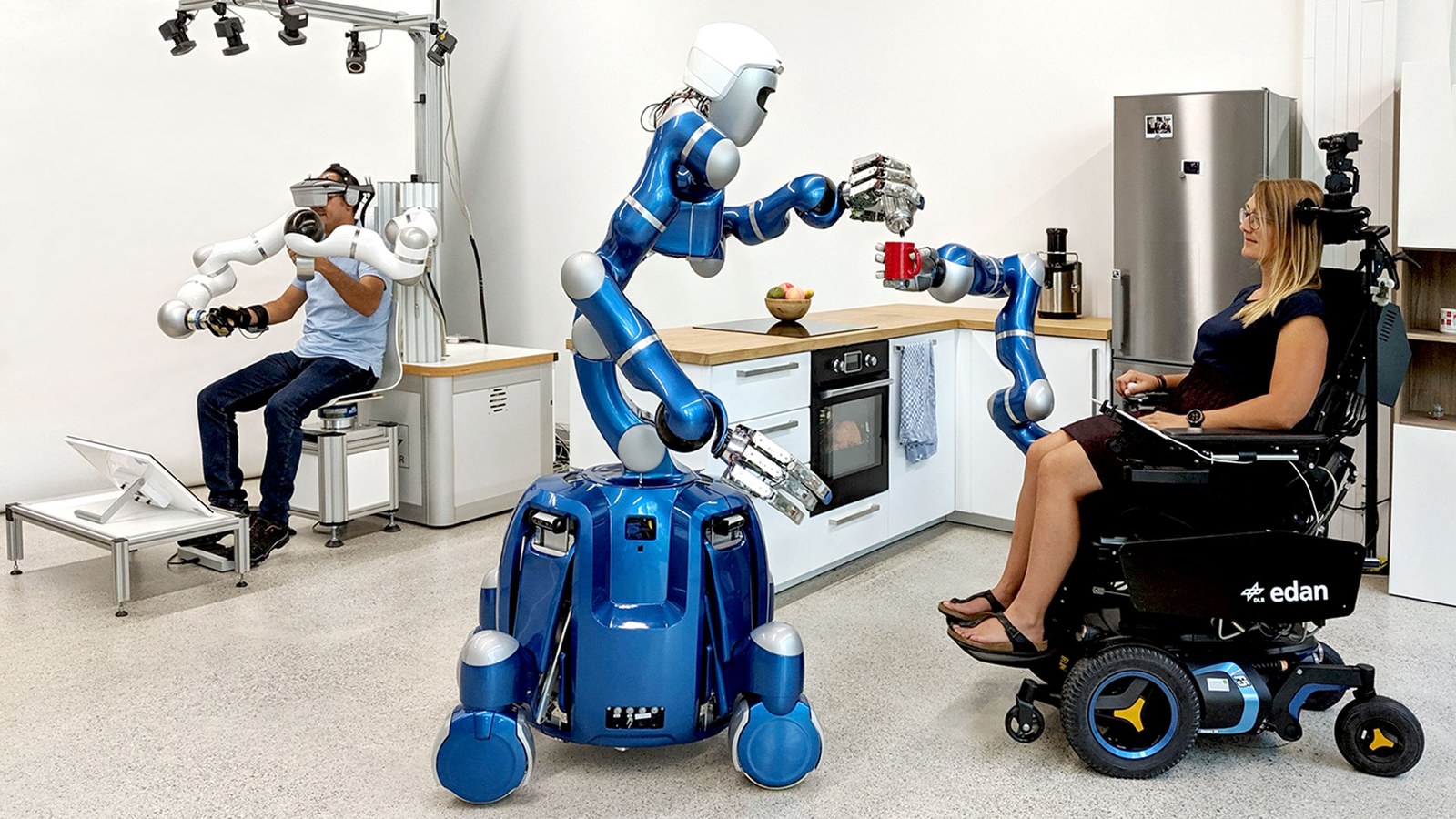Robotics highlights at automatica 2022



- DLR is exhibiting its robotics highlights at automatica 2022 in Munich from 21 to 24 June 2022.
- This year, DLR's exhibition focuses primarily on industrial and care assistance robotics.
- Focus: Industry 4.0, robotics, digitalisation
From 21 to 24 June, the German Aerospace Center (Deutsches Zentrum für Luft- und Raumfahrt; DLR) is presenting highlights of its robotics research at automatica 2022 in Munich, the leading trade fair for intelligent automation and robotics. This year, the DLR Institute of Robotics and Mechatronics exhibit focuses on the topics of the 'Factory of the Future' and the 'SMiLE' healthcare assistance project. In addition, partner institutes are exhibiting their latest developments and DLR spin-offs to show their successful technology transfer activities.
'Factory of the Future'
The goal of the DLR project 'Factory of the Future - Extended' is the digital transformation of robot-assisted manufacturing processes. A total of seven DLR institutes are working together across multiple disciplines and locations to achieve this. One of the DLR highlights at automatica is a flexible production network that consists of several reconfigurable workstations. The DLR SARA robotic arm is the central element of these modular stations. These workstations have a modular design and comprise a support structure, as well as the SARA robotic arm. Depending on the requirements, this modular system can independently configure itself with regard to the position of the components and the appropriate tools. Difficult tasks can be programmed intuitively by demonstration, using the special force-sensor technology incorporated in the robotic arm. The execution is sensitive, fast and precise.
To help make processes more flexible and efficient, 'SwarmRail' and 'FlappyBot' have been developed within the research area of mobile manipulation. Both concepts are based on a 'swarm' of mobile robots that move and cooperate autonomously. They have high economic potential for industry, logistics, vertical farming and the production of aircraft components made of fibre-composite materials. The DLR Center for Lightweight-Production-Technology in Augsburg is presenting a demonstrator for flexible production at automatica.
Simulations and digital twins, for example of components or entire systems, are indispensable for optimising production processes. An example of the virtual commissioning of an assembly process is demonstrated by the DLR Institute of System Dynamics and Control for 'Industry 4.0'.
The DLR Institute of Robotics and Mechatronics is also exhibiting its new 'Hybrid Compliant Gripper' for logistics applications. In addition to its two-finger gripper, it is equipped with a vacuum gripper that can collect objects from above and thus it can easily retrieve single items from a box full of objects.
Assistance and care robotics
Visitors to the exhibition can also explore new technologies for human care and assistance. The SMiLE (Servicerobotik für Menschen in Lebenssituationen mit Einschränkungen – service robotics for people with disabilities) 'ecosystem' presented, consists of various robotic systems, such as the humanoid robot 'Rollin' Justin' and the EDAN wheelchair robot. Their autonomous capabilities are continuously being upgraded and in the latest SMiLE2gether project, researchers are investigating how a control centre can expand the application possibilities of these robots by providing support from a distance. A special area is reserved for demonstrating the first prototype of such a control centre from which DLR robot systems can be remotely controlled, among other things by means of haptic teleoperation. Assistance robots are intended to facilitate the everyday lives of people with physical disabilities and could work in retirement homes, households and hospitals.
The DLR Institute of Robotics and Mechatronics is also presenting David, an anthropomorphic robot developed on the basis of a human model. David has two arms with dexterous hands, a torso, a neck and a head and is continuously being developed further to eventually become a complete, humanoid robot that can be used in an environment made for humans. To this end, David is to become as human as possible in terms of size, strength and dexterity.
Robotics expertise for SMEs and technology transfer
Last but not least, DLR's presence at the trade fair offers a glimpse of the MIRO Innovation Lab, the centre of excellence for medical robotics. Medical technology manufacturers, especially small and medium-sized enterprises, can gain access to expertise in the development of new robotic systems here. This includes access to the institute’s own MIRO research platform with various robotic arms for surgical interventions. As an interface between industry, research and clinical partners, the Innovation Lab team is available for questions and discussions on product developments as part of automatica 2022.
Robotics research is the driver of technology transfer. Numerous DLR spin-offs are therefore also exhibiting at the trade fair. The latest spin-off, Leverage Robotics, develops highly flexible robot assembly stations for safe and efficient human–robot collaboration.
